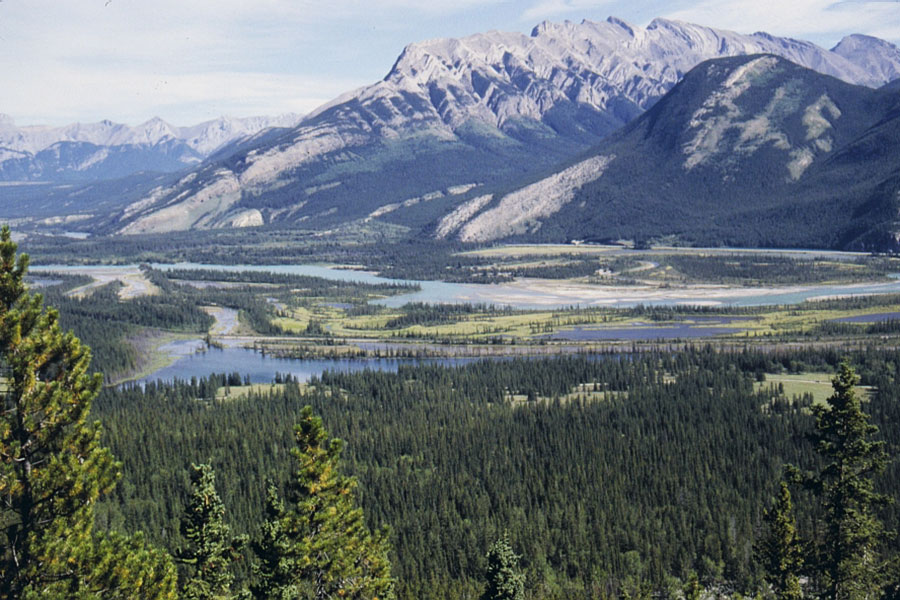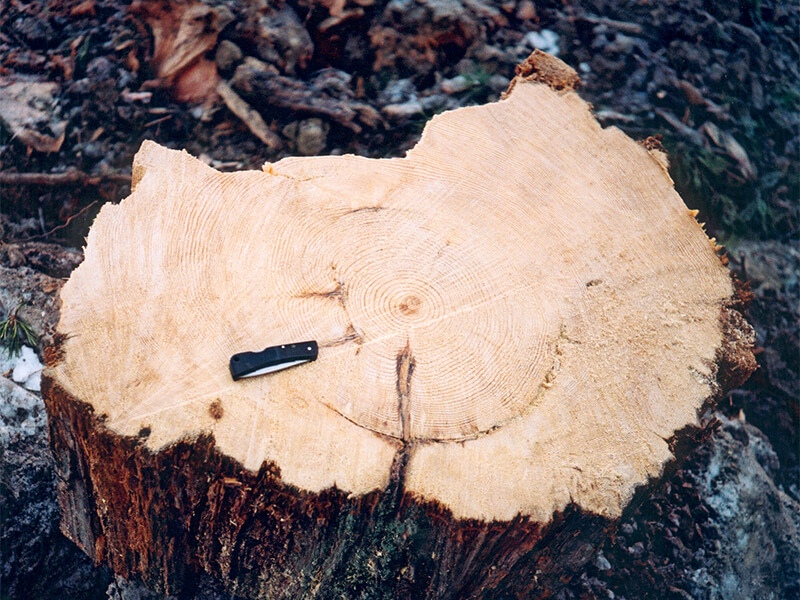
Looking out over the Athabasca River in Jasper National Park.
By Ben Williamson
In the warm, dry year of 1646, a fire burned in Jasper National Park on the mountain slopes beside the Athabasca River. The flames swept down the valley on the wind, consuming many trees. But some, by adaptation or chance, survived to grow on. In fact, they may have flourished as their neighbours that once crowded them toppled one by one. Nutrients cycled back into the soil and the canopy re-opened to the sky; a new understory sprang up under the fire-branded surviving trees.
In scorches and scars, nature carved this story on the forest and a team of researchers with the Healthy Landscapes Program have become adept at reading it. Raphaël Chavardès and Lori Daniels led Ashley Dobko, Taylor Martin, Skyler Desroches, and Sarah Ravensbergen on a search through 3,300 hectares of forest in the valleys and on mountain slopes, looking for fire-scarred trees, logs, stumps, and snags. They cut a cross section from some of these and counted back the tree rings to see how long ago the fire left its mark.

Douglas-fir (left) and lodgepole pine (right) report the fires they have seen.
The team can only read about less severe fires in this way—fires where enough trees survive to tell the tale. But sometimes the conditions are different and most of the green growing things are incinerated. Even then, the landscape tells the story of the fire by what grows around the edge of the burned patch, and by what is missing inside. If there are no trees in a stand older than 99 years, then it’s a good bet that there was a fire 100 years ago.
To find the oldest trees, and therefore the oldest fires, the team drilled cores—thin slivers of the trunk bored straight from the bark to the center, or pith, of the tree. If the core is good, it will cross every ring and reveal a story about every year of the tree’s life so far. (Good coring is an art: it is no easy task to look at a tree and guess where the sapling grew in its first year of life many years ago, so you can angle the core to the pith.)

Coring a tree. Photo credit: Cameron Naficy
The team wanted to know more than just the age of the forest stands, and so they measured as well as counted the rings. Wide rings tells of good times; of a year when the rain fell regularly and weather was pleasant and the tree made lots of new wood. The thin spaces crushed between rings report a hard, bitter year of drought and stress and survival, when almost no energy could be spared for new growth.
Douglas-fir offer these reports with particular clarity, matching well enough the instrument weather and climate records. This is how the team has learned that there are many stories like the 1646 fire. As you might expect, fire years were very often times of drought. But there were exceptions; it was in the wetter, cooler years of 1711 and 1901 that Jasper saw wildfire.

A Douglas-fir tree with a tale to tell.
Between 1646 and 1915, there have been forest fires in this area of Jasper National Park every 16 years on average—or maybe better to say at least that often, because the records of early fires kept in surviving trees could still be burnt up in later blazes. In nearly all of the recorded fires, climate was the main factor. There was some chance, of course, in where and when lighting struck to ignite a blaze. And we know from the Forest History Program that people have for hundreds of years been clearing land for forage and hunting by starting fires in spring.
But then in 1907, the government established the park. Local people were displaced, fire use was prohibited, and by 1913 fire was actively suppressed. In 1915 there was one more wildfire in the study area. Since then, none have reached even a hectare in size before being snuffed out.

The question burning in the minds of the researchers was why? Has the climate in Jasper just been unusually cool and wet for the last 103 years? Have there not been lightning strikes to ignite another wildfire? No. There have been many drought years since 1915; there have been 101 lightning ignitions that we know of (and probably many more that we don’t).
And yet across the entire 92,000-hectare park, there have been only eight fires that grew larger than 40 hectares before they were extinguished. There is only one credible explanation: for more than 100 years in Jasper, the diligent efforts of humans to suppress fires have usurped climate as the main influence.
The mosaic of forest patches of all ages and densities created by small, periodic fires that has long been the norm, was replaced by an aging forest unprecedented in its density and uniformity across the landscape, a homogenous tangle of understory under a largely unbroken canopy.

In the Athabsca valley at the study area.
For a century the fuel has piled up and only in recent times have managers seen the danger and begun to change course by thinning the woods and defusing built up fuel with their own small fires. But if—in a flash—nature reasserts control before this work is far along, it will carve very deeply a new story into the landscape.
Find the paper by Chavardès and the rest of the team here. Or, watch a webinar by Chavardès on the topic here.
This project is retracing the steps of an earlier Healthy Landscapes Program project. Find the results of that here.








